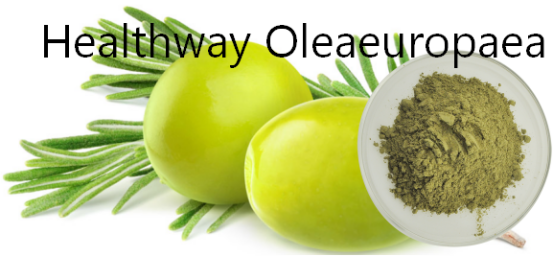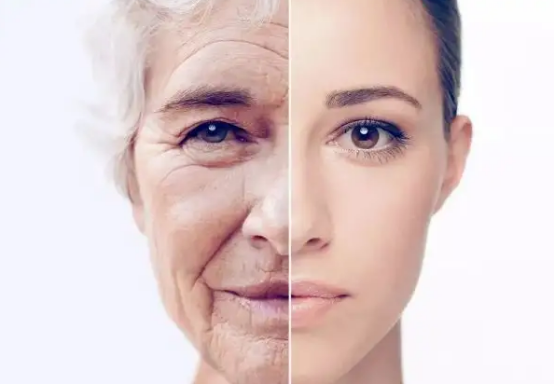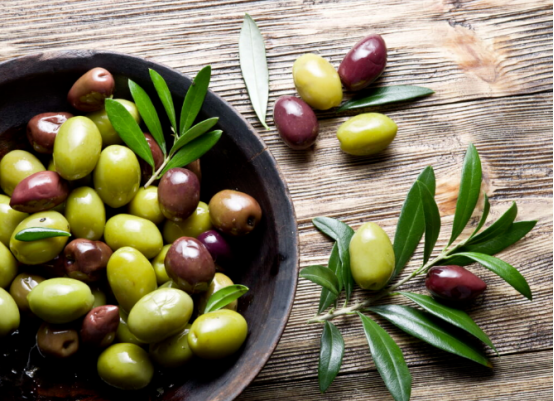Antioxidant activity of olive fruit extract and its role in skin health
10/27/2025 11:38:41
L. is an evergreen tree of the genus Oleaceae, and is a world-famous woody oil tree species with a cultivation history of more than 4,000 years. Olives are mainly distributed in Mediterranean countries, with Greece, Italy, Tunisia, and Spain as the main production areas. Since ancient times, products made from olives have been used as food and traditional medicine. Studies have shown that olives have a variety of biological and pharmacological activities such as enhancing heart health, anti-cancer, antibacterial, and anti-inflammatory. Modern biotechnology analysis shows that the active substances in olives are mainly olive polyphenols, flavonoids, schizocyclopentane (including oleuropein), biflavonoids, etc., and the content of antioxidant bioactive substances is higher than that of olive fruits and stems.
This article reviews the antioxidant research of olive polyphenols, indicating that the free radical scavenging ability of olive polyphenols may also have a direct impact on skin health.

1. Review of the main chemical composition and antioxidant research in olive fruit
The oil content of olive fruit is as high as 30%. Cultivated olives are mainly processed into olive oil using the oil in the fruit. According to biochemical analysis, olive oil is composed of saponifiable matter and unsaponifiable matter. The saponifiable matter includes free fatty acids and triglycerides, with triglycerides accounting for about 98.5%; unsaponifiable matter accounts for about 1.5%, including free alcohols, triterpenes, pigments (chlorophyll and carotenoids), tocopherols, polyphenols, sterols, hornbene and volatile components. The composition of polyphenolic compounds such as oleuropein and flavonoids in olive leaves is complex. Domestic and foreign scholars have conducted in-depth research on the chemical composition of olives and have isolated more than 100 compounds. The main antioxidant bioactive components of olive are oleuropein, hydroxytyrosol, flavonoids, lignans, etc., and small molecular diphenol compounds with the parent structure of hydroxytyrosol have the most antioxidant activity, among which hydroxytyrosol and oleuropein are hot topics of research at home and abroad. Sun Jin et al. studied the in vitro antioxidant activity of olive polyphenols obtained after extraction and purification by measuring their reducing power, free radical scavenging ability, and inhibitory effect on oil peroxidation, and compared them with VC and BHT. The results showed that olive polyphenols have a strong scavenging effect on hydroxyl radicals and nitrites. Within a certain range, the scavenging effect increases with the increase of mass concentration. In addition, at the same concentration, the scavenging rate of olive polyphenols for superoxide anion radicals is lower than that of VC and BHT. Other studies have tested olive phenol extracts in different antioxidant systems. The results show that olive phenol extracts have stronger free radical scavenging ability and iron ion reducing power than BHA (and food antioxidant butylated hydroxyanisole) and VC, and have better in vitro antioxidant capacity. Many experiments have shown that olive polyphenol extracts have strong free radical scavenging ability and high antioxidant activity; and in each system, there is a good dose-effect relationship between the antioxidant activity of olive polyphenol extracts and their concentration. The antioxidant activity of olive polyphenols is a comprehensive effect, and the antioxidant activity mainly comes from the large amount of hydroxytyrosol in the polyphenol molecules. Hydroxytyroso(hydroxytyrosol),also known as 3, 4-dihydroxyphenylethanol, is a natural antioxidant that is widely present in the branches, leaves and fruits of olives, especially in the olive trees in the Mediterranean region. It is an effective ingredient in olive oil. A large number of studies have shown that hydroxytyrosol has a strong antioxidant effect. As a hydrogen donor, hydroxytyrosol has a scavenging effect on a variety of reactive oxygen species. It can reduce singlet oxygen 1O2 to less active triplet oxygen 3O2, reducing the possibility of oxygen free radical generation. It is also an effective scavenger of various free radicals, generating less active polyphenol free radicals, interrupting the chain reaction of free radical oxidation; and can prevent the self-oxidation of polyunsaturated fatty acids and prevent DNA from being damaged by oxidation.
Abnormal metabolism of the body produces a large number of oxygen free radicals. When the number of oxygen free radicals exceeds the antioxidant defense capacity of the body, it will cause cell damage, and the body is in an oxidative stress state. Oxidative stress is caused by the imbalance of reactive oxygen species (ROS) and cellular antioxidant capacity, which will affect most cell components, such as lipids, proteins and DNA. Oxidative stress has a significant direct relationship with disease, which can lead to sub-health and even disease. Epidemiological studies have shown that a large amount of antioxidants in food can effectively fight oxidative stress. Pharmacological data and clinical trials have shown that olive fruit extract can effectively improve antioxidant defense capacity and fight oxidative stress]. For example, by measuring the excretion of the oxidation marker 8-isoprostane (8-isoprostane F2α) in rats, it was proved that olive fruit extract has a significant antioxidant effect in rats. In addition, another clinical trial took 19 healthy subjects 400 mg of olive fruit extract every day for 4 consecutive weeks. The urine excretion of the oxidative stress marker.
8-isoprostane was measured before the start of the study and after the four-week treatment. The experiment showed that olive fruit extract significantly reduced the formation of oxidation markers (47%, P < 0.05 average data) and significantly improved the oxidation status of healthy subjects.
2. Research progress on olive fruit extract for skin
Health Skin aging and body aging are simultaneous, and skin aging is part of body aging. Because the skin is located in the outermost layer of the body and is more affected by exogenous factors, skin aging is the result of the combined action of endogenous and exogenous factors. Exogenous skin aging is related to ultraviolet (UV) radiation, wind, smoking, drinking, and contact with irritants. Long-term UV exposure is the most important factor in the environment that promotes skin aging, so exogenous aging generally refers to photoaging.

Photoaging has clinical and histological characteristics. The main clinical manifestations are: loose skin, coarse and deep wrinkles, nodules, leathery appearance, increased pigmentation, dilated capillaries, clear changes or disappearance of the original geometric appearance, grayish yellow skin color, and various benign, precancerous or malignant tumors. The main histological manifestations of photoaged skin are: inflammatory cell infiltration in the dermis, thickening of elastic fibers, disordered arrangement or aggregation into clusters, degeneration of collagen in the upper dermis, and finally becoming an amorphous substance; dilation and distortion of skin capillaries, and finally becoming extremely sparse, focal proliferation of melanocytes, etc. Many changes in photoaged skin, such as coarse and fine wrinkles, rough skin and pigmentation, can be improved and reversed by drugs, and it is possible to treat and prevent photoaging of the skin. In the investigation of the relationship between skin wrinkles and dietary structure, it was found that people who consume a large amount of olive products on a daily basis have relatively fewer skin wrinkles. It is further speculated that the free radical scavenging ability of olive polyphenols may also have a direct impact on skin health, including preventing the oxidation effects related to wrinkle formation, skin thinning and dehydration. And studies have continued to prove the correctness of this inference. In recent years, domestic and foreign studies have conducted fruitful research on the preventive and therapeutic effects of olive fruit extract on skin photoaging, which are summarized as follows.

2.1 Promote the health of sun-exposed skin In a placebo-controlled trial, 13 male subjects were given oral olive fruit extract at a dose of 160 mg/day for 4 consecutive weeks. Then, the back area was continuously exposed to ultraviolet rays (UVA+UVB 0.45 Mw/cm2) at doses of 0.054
J/cm2 to 0.135 J/cm2. The minimum erythema dose (MED) was measured before and after oral olive fruit extract. The results showed that olive fruit extract increased MED by an average of 16.45 % (P<0.01), indicating that olive fruit extract helps promote the health of sun-exposed skin [30]. In addition, by simulating the situation in vivo, such as the generation of superoxide anions in tissues and cells after skin exposure to ultraviolet rays, the study showed that polyphenols in olive fruit extract have the ability to scavenge reactive oxygen species such as superoxide anions.
O2-[34-35]. The single-electron reduction of oxygen in the body, enzymatic oxidation and autooxidation of biological molecules can all produce various oxygen free radicals. The strong reactivity of these free radicals is the main cause of cellular oxidative damage and aging. The in vitro antioxidant activity study of olive polyphenols showed that olive polyphenols have good antioxidant properties, especially in scavenging hydroxyl free radicals, showing obvious advantages.
2.2 Repair the epidermal permeability barrier and prevent the formation of photoaging wrinkles caused by ultraviolet rays Ultraviolet radiation can damage the epidermal permeability barrier of the skin. A study fed adult hairless mice 6.25 mg/kg~125 mg/kg of verbascoside from olive fruit extract every day for 11 days. TEWL (transepidermal water loss) was measured on the day, 3rd day, and 4th day after UV irradiation, and it was found that TEWL decreased significantly, indicating that verbascoside played a protective role on the epidermal permeability barrier[29]. Sunlight promotes photoaging and wrinkle formation. In an experiment, adult hairless mice were exposed to UVA and UVB, while the dose of UV was continuously increased, and the mice were fed olive fruit extract. The wrinkle formation of each mouse was measured according to the wrinkle rating scale. The results showed that the rate of UV-induced wrinkle formation was reduced by 38% after taking olive fruit extract (P<0.001); at the same time, because epidermal thickness is a useful parameter for evaluating UV-induced skin inflammation, epidermal thickness was measured to be reduced by 28%.
2.3 Inhibition of skin lipid peroxidation Dry skin is caused by oxidative stress in lipid-rich tissues [36-37]. Lipid peroxides are the main non-radical intermediates for dry skin. A clinical evaluation was conducted on 23 healthy male subjects, who applied a preparation containing olive fruit extract and a placebo to both cheeks twice a day for 3 consecutive months. The moisture content of the stratum corneum, skin elasticity, and skin texture were measured before the start of the study, at week 8, and at week 12. Compared with the placebo group, the sample containing olive fruit extract showed a significant improvement in the roughness parameter in the texture analysis. At the same time, the moisture content in the stratum corneum also showed an improvement trend .
2.4 Inhibition of glucosidase Healthy blood sugar metabolism is essential for skin health. High blood sugar levels cause metabolic disorders in the human body. Glucose cannot be utilized in the patient's body, protein and fat consumption increase, and the normal nutrients required for tissues and cells cannot be supplied, causing a decline in immunity. In addition, high blood sugar levels are also a good culture medium for various bacteria and fungi, so it is easy to be infected by bacteria and cause fungal skin infections, such as tinea corporis, tinea unguium, tinea pedis, etc.. The activity of α-glucosidase was tested using olive fructose extracts of different concentrations. The results showed that olive fruit extracts had a good inhibitory effect on this enzyme and could promote skin health by maintaining healthy blood sugar metabolism.
3. Conclusion In summary
The antioxidant and free radical scavenging abilities of olive fruit extracts have shown their beneficial effects at the skin level, and can effectively deal with free radical-mediated stress problems, such as wrinkle formation and epidermal barrier damage, making them have broad application prospects in food additives, cosmetics, health foods and pharmaceutical industries. However, the chemical components in olive fruit extract, especially olive polyphenols and hydroxytyrosol, have complex antioxidant and anti-skin photoaging mechanisms. Current research is mostly limited to in vitro biological experiments and animal tests, with few clinical studies. The role of olive fruit extract in skin health requires more theoretical and clinical data support.




